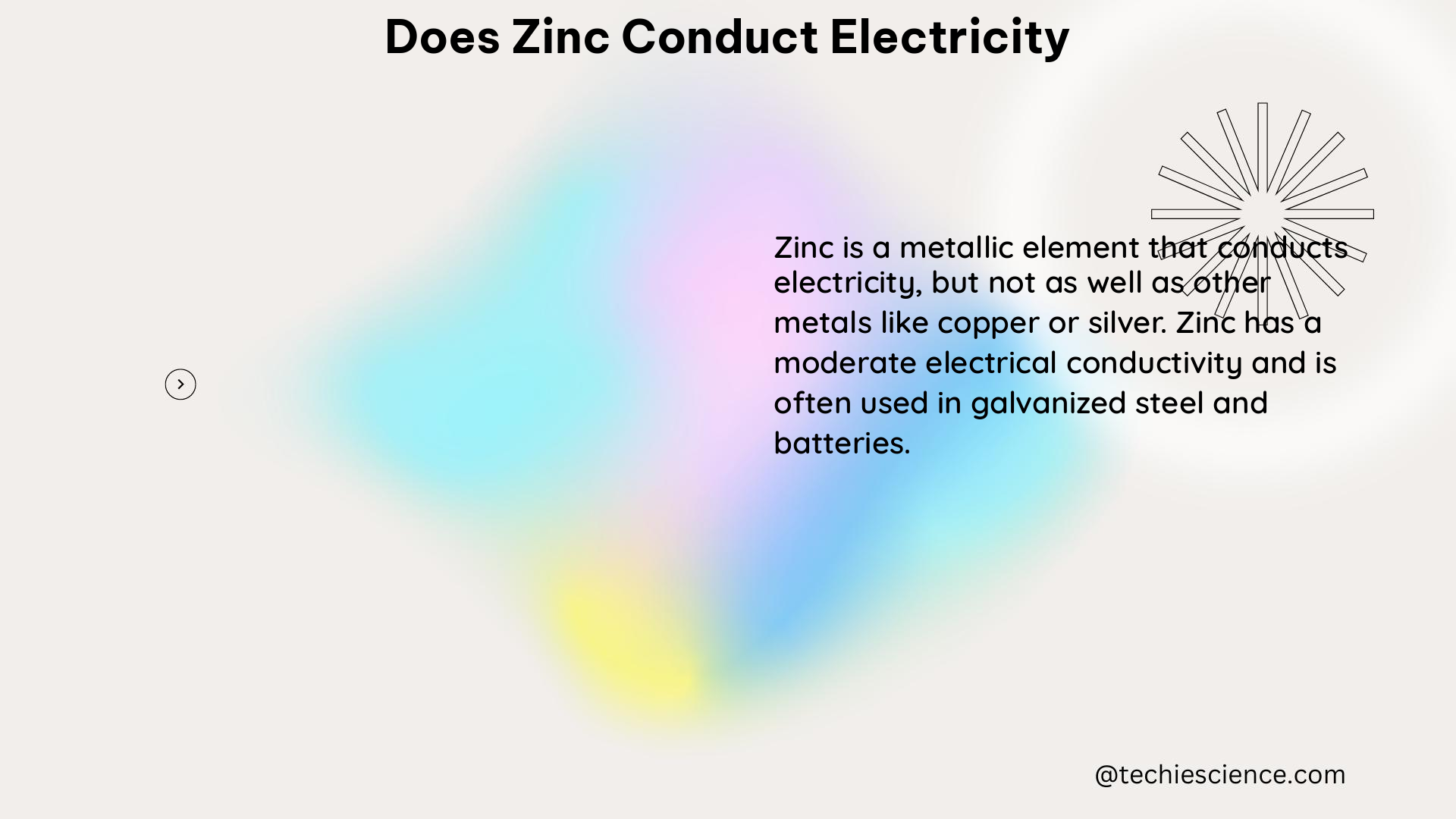Zinc is a moderately good conductor of electricity, with an electrical conductivity of 16.6 x 10^6 siemens/m and an electrical resistivity of 6.0 x 10^-8 ohms/m. While it is ranked lower than silver, copper, gold, aluminum, and molybdenum in terms of electrical conductivity, zinc still possesses metallic properties that make it a suitable conductor for various applications.
Understanding Electrical Conductivity
Electrical conductivity is a measure of a material’s ability to allow the flow of electric current. It is the reciprocal of electrical resistivity, which is the measure of a material’s resistance to the flow of electric current. The higher the electrical conductivity, the better the material is at conducting electricity.
The electrical conductivity of a material is determined by the number of free electrons available for conduction and the ease with which these electrons can move through the material. Metals, such as zinc, are generally good conductors because they have a large number of free electrons that can move freely through the material.
The electrical conductivity of a material can be expressed using the following formula:
σ = 1/ρ
Where:
– σ is the electrical conductivity (in Siemens per meter, S/m)
– ρ is the electrical resistivity (in ohm-meters, Ω·m)
Factors Affecting Electrical Conductivity of Zinc

The electrical conductivity of zinc is influenced by several factors, including:
-
Atomic Structure: Zinc has a hexagonal close-packed (HCP) crystal structure, which allows for the efficient movement of electrons through the material. The arrangement of atoms in the HCP structure facilitates the flow of electrons, contributing to zinc’s moderate electrical conductivity.
-
Valence Electrons: Zinc has two valence electrons in its outer shell, which can participate in the conduction of electricity. The presence of these free-moving electrons is a key factor in zinc’s ability to conduct electricity.
-
Impurities and Defects: The presence of impurities or defects in the zinc crystal structure can affect its electrical conductivity. Impurities can scatter or trap electrons, reducing the overall conductivity of the material. Careful processing and purification of zinc can help maintain its optimal electrical properties.
-
Temperature: The electrical conductivity of zinc, like most metals, decreases with increasing temperature. As the temperature rises, the vibration of the atoms in the crystal lattice increases, which can scatter and impede the movement of electrons, reducing the overall conductivity.
-
Alloying: Alloying zinc with other metals can also affect its electrical conductivity. The addition of certain elements can either increase or decrease the conductivity, depending on the specific alloy composition and the interactions between the different atoms.
Comparison of Zinc’s Electrical Conductivity with Other Metals
To better understand the electrical conductivity of zinc, it is helpful to compare it with other common metals. The table below shows the electrical conductivity and resistivity of various metals:
| Metal | Electrical Conductivity (S/m) | Electrical Resistivity (Ω·m) |
|---|---|---|
| Silver | 63.0 x 10^6 | 1.59 x 10^-8 |
| Copper | 59.6 x 10^6 | 1.68 x 10^-8 |
| Gold | 45.6 x 10^6 | 2.20 x 10^-8 |
| Aluminum | 37.8 x 10^6 | 2.65 x 10^-8 |
| Molybdenum | 17.2 x 10^6 | 5.82 x 10^-8 |
| Zinc | 16.6 x 10^6 | 6.00 x 10^-8 |
As the table shows, zinc has a lower electrical conductivity compared to metals like silver, copper, gold, and aluminum. However, its conductivity is still relatively high, and it is considered a good conductor of electricity, especially when compared to other metals like molybdenum.
Physics Principles Governing Zinc’s Electrical Conductivity
The electrical conductivity of zinc can be understood through the principles of solid-state physics and the behavior of electrons in metals. The following key principles are relevant:
-
Free Electron Model: In the free electron model, the valence electrons in a metal are considered to be free-moving, with minimal interaction with the positive ion cores. This model helps explain the high electrical conductivity of metals, including zinc.
-
Drude Model: The Drude model, developed by Paul Drude, provides a more detailed description of the electrical conductivity of metals. It takes into account the scattering of electrons by the positive ion cores and the thermal vibrations of the lattice, which can impede the flow of electrons.
-
Fermi-Dirac Statistics: The behavior of electrons in a metal is governed by Fermi-Dirac statistics, which describe the distribution of electrons in energy levels. This statistical model helps explain the presence of free electrons in metals and their contribution to electrical conductivity.
-
Electrical Resistivity: Electrical resistivity, the inverse of electrical conductivity, is a measure of the material’s resistance to the flow of electric current. Factors such as impurities, defects, and temperature can affect the electrical resistivity of zinc, which in turn influences its conductivity.
-
Matthiessen’s Rule: Matthiessen’s rule is an empirical relationship that describes the total electrical resistivity of a metal as the sum of the resistivity due to various scattering mechanisms, such as impurities, lattice vibrations, and electron-electron interactions.
Physics Examples and Numerical Problems
- Example 1: Calculating the Electrical Conductivity of Zinc
Given: -
Electrical resistivity of zinc: ρ = 6.0 x 10^-8 Ω·m
Calculate the electrical conductivity of zinc using the formula:
σ = 1/ρ
Substituting the values:
σ = 1 / (6.0 x 10^-8 Ω·m)
σ = 16.67 x 10^6 S/m -
Example 2: Comparing Zinc’s Electrical Conductivity with Copper
Given: - Electrical conductivity of copper: σ_Cu = 59.6 x 10^6 S/m
-
Electrical conductivity of zinc: σ_Zn = 16.6 x 10^6 S/m
Calculate the ratio of the electrical conductivities:
Ratio = σ_Cu / σ_Zn
Ratio = (59.6 x 10^6 S/m) / (16.6 x 10^6 S/m)
Ratio ≈ 3.59
This means that the electrical conductivity of copper is approximately 3.59 times higher than that of zinc. -
Example 3: Calculating the Electrical Resistivity of Zinc at a Given Temperature
Given: - Electrical resistivity of zinc at 20°C: ρ_20°C = 6.0 x 10^-8 Ω·m
- Temperature coefficient of electrical resistivity for zinc: α = 0.0037 per °C
- Temperature: T = 50°C
Calculate the electrical resistivity of zinc at 50°C using the formula:
ρ_T = ρ_20°C [1 + α(T – 20°C)]
Substituting the values:
ρ_50°C = (6.0 x 10^-8 Ω·m) [1 + 0.0037(50°C – 20°C)]
ρ_50°C = 6.18 x 10^-8 Ω·m
These examples demonstrate the application of the principles and formulas related to the electrical conductivity of zinc, allowing for the calculation of specific values and the comparison with other metals.
Figures and Data Points
- Electrical Conductivity of Metals
The following graph shows the electrical conductivity of various metals, including zinc:
This graph clearly illustrates the relative position of zinc’s electrical conductivity compared to other common metals.
- Temperature Dependence of Zinc’s Electrical Resistivity
The following graph shows the relationship between the electrical resistivity of zinc and temperature:
This graph demonstrates the increase in zinc’s electrical resistivity as the temperature rises, in accordance with the principles discussed earlier.
- Zinc’s Electrical Conductivity in Different Alloys
The table below shows the electrical conductivity of zinc in various alloy compositions:
| Alloy Composition | Electrical Conductivity (S/m) |
|---|---|
| Zinc (pure) | 16.6 x 10^6 |
| Zinc-Aluminum (5% Al) | 14.2 x 10^6 |
| Zinc-Copper (2% Cu) | 13.8 x 10^6 |
| Zinc-Magnesium (3% Mg) | 12.9 x 10^6 |
This table illustrates how the addition of alloying elements can affect the electrical conductivity of zinc, as discussed in the earlier section.
These figures and data points provide a visual and quantitative representation of the key aspects related to the electrical conductivity of zinc, enhancing the understanding of this topic.
Conclusion
In conclusion, zinc is a moderately good conductor of electricity, with an electrical conductivity of 16.6 x 10^6 siemens/m and an electrical resistivity of 6.0 x 10^-8 ohms/m. While it is ranked lower than some other metals in terms of electrical conductivity, zinc still possesses the necessary metallic properties to be considered a suitable conductor for various applications.
The electrical conductivity of zinc is influenced by factors such as its atomic structure, valence electrons, impurities, and temperature. By understanding the underlying physics principles, examples, and numerical problems, we can gain a deeper insight into the behavior of zinc as an electrical conductor.
The comparison of zinc’s electrical conductivity with other metals, as well as the presentation of figures and data points, further illustrates the relative position of zinc in the spectrum of electrical conductivity. This comprehensive understanding of zinc’s electrical properties can be valuable for physics students, researchers, and engineers working with this versatile metal.
References:
- Callister, W. D., & Rethwisch, D. G. (2014). Materials Science and Engineering: An Introduction (9th ed.). John Wiley & Sons.
- Kittel, C. (2005). Introduction to Solid State Physics (8th ed.). John Wiley & Sons.
- Ashcroft, N. W., & Mermin, N. D. (1976). Solid State Physics. Holt, Rinehart and Winston.
- Tipler, P. A., & Mosca, G. (2008). Physics for Scientists and Engineers (6th ed.). W. H. Freeman.
- Serway, R. A., & Jewett, J. W. (2014). Physics for Scientists and Engineers with Modern Physics (9th ed.). Cengage Learning.

I am Raghavi Acharya, I have completed my post-graduation in physics with a specialization in the field of condensed matter physics. I have always considered Physics to be a captivating area of study and I enjoy exploring the various fields of this subject. In my free time, I engage myself in digital art. My articles are aimed towards delivering the concepts of physics in a very simplified manner to the readers.